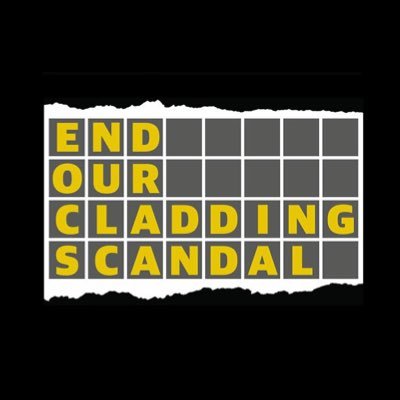
Fire Safety in Your Home
Resident backed campaign for a national Fire Safety Scheme.
The cost of removing cladding from Tower blocks has been quoted as costing from an average of £40,000 up to a staggering £115,000 per flat.
Even with the proposed increase of 2,000 engineers to undertake this work, it is likely to take up to 20 years to complete, at a cost of some £16 billions.
In the meantime, the occupants are living “at risk”. Nothing is 100% safe, "A tolerable level” is the benchmark used by the HSE to judge safety issues.
Advice given by MHCLG suggests that where unacceptable cladding panels are in place and no means of mitigation of fire risk exists, the panels should be removed. By implication, this must mean that where mitigation does exist, the panels do not need to be removed.
The mitigations and arrangements of the below Fire Safety Strategy could be provided for around £7,000 or less per flat, which is about 10-15% of the cost of removing the panels.
Overall, this would provide a higher degree of safety than removing the panels and may be completely affordable out of the funds the Government has supposedly committed to the resolution of the problem. Or, similar to the Green grants scheme, a national scheme could cover 75%-100% of these reduced costs.
The real difficulty here is that no-one in goverment appears to have the intellect or willingness to look outside the box.
Strategy
Better Fire Safety - Without Going Bankrupt.
Misting sprinkler systems in homes should be as synonymous as seat belts in cars.
1. PREVENT
-
Fire Prevention Booklets
-
Fire Risk Assessment (FRA)
-
Fire Performance Certificates
2. WARN
-
Smoke / Fire Alarms
-
Building wide Alarm system (optionally connected to Fire Brigade)
-
Waking Watch Patrols
3. SUPPRESS
-
Misting Sprinklers
-
Call Fire Brigade
-
Fire Extinguishers (Kitchen)
-
Fire Blankets (+ Evacuation)
-
Water Sprinklers (Communal bin stores)
-
Chemical fire extinguishers (Electrical cupboards)
-
Personal Fire Risk Assessments (PFRA)
4. EVACUATE
-
Protect The stairwell at all costs
-
Practice fire drills
-
Evac Chairs / Smoke Hoods
-
Personal Emergency Evacuation Plan (PEEP)
1. PREVENT
Equip and educate residents with the skills & knowledge to prevent fires
Fire Prevention booklet
Supply all households with an info pack like Estate Fire Safety - What you should know. With comprehensive information & illustrations to explain to residents how to prevent fires & what to do in case of one.
Fire Risk Assessments FRA
Fire Risk Assessments should be available for all residents to access. FRA to be given in welcome packs to any new resident. It's important that the status of fire safety issues in our buildings is understood. Residents need full transparency of issues. For instance we noticed that our FRA mentioned multiple failures in bin chutes which we demanded our council fix. FRA assessors should consider the occupants and the suitability of evacuation plans. In the eyes of the law, 'suitable and sufficient' is the minimum requirement for an FRA.
Fire Performance Certificates FPC
Similar to Energy Performance Certificates (EPC). Abodes should have a "Fire Performance Certificate" online. They should both be grouped together as one "Energy & Fire Performance Cert" (EFPC) to reduce costs.
2. WARN
A series of interconnected smoke & heat detectors should be provided in each flat and connected to a central intelligent alarm control panel.
This will ensure that the alarm is sounded in the areas at greatest risk first (fire floor & floor immediately above).
The alarm will then be sounded progressively in other parts of the building if the fire spreads.
It's importance to alert and support your neighbours to evacuate safely if you are able.
Smoke / Fire Alarms
Many local fire services in the UK offer them for free (ask yours). Nest Protect is a top of the range device. Amazon or your local hardware store will have a range of cheaper options. Misting sprinkler systems such as Plumis Automist have integrated smoke/fire detectors.
Building wide systems Alarms
Building wide systems like Hush Pro offer the highest level of detection thus giving occupants ample time to evacuate.
Waking Watch
Waking watches are a waste of money. They are a highly unreliable way to detect fires and thus warn residents of them. Residents have already forked out enough money to cover the costs of misting sprinklers being installed. This is INSANE.
3. SUPPRESS
Actively suppress fires with a system of water/mist sprinklers to control or extinguish any fire that occurs, in its early stages.
This should prevent the fire from spreading and involving nearby combustible substances, or penetrating windows or patio doors and involving any external cladding.
REMEMBER If you have a fire, raise the alarm first. Call emergency services. LFB advice is to leave your home, closing all doors as you go. This is sound advice that you should follow. If you have had training, know how to use firefighting equipment and confident fighting a small fire. Please still call Emergency Services first. Don't wait till a real fire to test your knowledge. Book a Fire Safety Home Visit. Consider using your mobile to call Emergency services (999) handsfree. (We're sure they will not mind if a fire is extinguish while on the call.)
Use Emergency SOS on your iPhone, or "Hey Siri, Emergency".
Get help in an emergency using your Android phone
Misting Sprinklers
An intelligent, modular, misting sprinkler system, capible of being connected to a central control solves a lot of the concerns residents have about water egress and pipe-work maintenance.
An example of such a system is UK based Plumis Automist who offer some the latest innovations in fire safety. These systems are a step change in performance and protection over traditional water sprinklers in residential settings.
They can keep conditions survivable for longer, offering greater protection from smoke/toxic fumes ( the number 1 killer in fires).
See our comparison chart.
The single best thing you can do to improve fire safety in your home is to install a sprinkler system like this.
Fire Extinguishers
Small fire extinguishers are cheap and easy to use. Every kitchen should have one. B&Q has a range of cheap items for early suppression of small fires in the home. Video demonstrating how to use them
Fire Blankets
Fire blankets are very handy and serve 2 purposes! They can be used to put over fires. Video demonstrating how to use them. You can also wrap them around yourself to escape a fire.
Water Sprinklers
Where there are areas in a building with large amounts of material that could become fuel for a fire. Water sprinklers are appropriate. i.e communal bin cupboards with bin chutes.
Chemical Fire Extinguishers
Electrical cupboards aren't always maintained well. A fire in one has the potential for internal, vertical, fire spread up service areas of a building. Installing Co2 Gas or Foam extinguishers here will mitigate the risk.
Personal Fire Risk Assessment (PFRA)
Generally, People start fires - not buildings. Some people are more susceptible to fire than others; Eldery, those with mobility issues etc. Local Authorities should make sure all their vulnerable residents have a PFRA, prioriting retrofitting modular misting systems and other fire safety equipment based on residents needs. Over time blocks of flats could reach 100% coverage in a smart roll-out.
4. EVACUATE
'Stay put' has been discredited. It seems unlikely that the current stock of high rise properties can be remediated in the short to medium term and therefore
a policy of controlled simultaneous evacuation should be introduced.
This should be in the form of phased evacuation initiated and controlled by the fire detection & alarm system. As well as directed by Fire Service Incident Commander at the scene.
Protect the stairwell at all costs
The single most important space in a building to manage a fire is the stairwell. Stairwells need multiple layers of protection to keep them free from smoke and clean. Usable for residents to go down to evacuate and for firefighters to go up and fight fire. If stairwells can be kept free from smoke they can be refuge points too. Fire doors must have working self-closures with smoke seals. Stairwells should have ventilation / smoke extractors. Stairwells must avoid multiple defects to the extent that residents may face serious risks evacuating or their escape route becomes untenable in a major fire.
Evac Chairs
Residents with mobility issues may need assistance and evacuation equipment like Evac Chairs. If you're an able bodied person living in block of flats. Recognise the communal living life-style. Be a Fire Angel if you know of any neighbours who might need assistance in an evacuation. Don't wait until a fire occurs. Talk to them now. Learn how to use an Evac Chair and how to help them to safety. A Fire safety scheme could offer incentives for conscientious residents to have training for Evac Chairs or to be a Fire Marshalls. (Service charge discounts or other recognition?)
Escape Hoods
Residents living above the 3rd floor should be encouraged and incentivised to own Smoke hoods. This will give extra protection from smoke and help in buildings with poorly protected stairwells that could fill with smoke in the event of a major fire. You can also take them with you when staying in hotels in UK or abroad. Giving you further piece of mind. Dräger are market leaders in escape devices. Whatever you chose make sure it's certified for at least 15mins use and meets EU/UK standards. Fire service departements should bring smoke hoods to the scene. If you have your own you don't need to rely on others.
Fire Drills
It's very useful to have a fire drill, teaching residents how to evacuate calmly, moving away from the exits as they leave. This will ensure escape routes are kept clear for those following on behind. All residents should know the safe assembly point to go to. Fire fighters will help manage residents evacuation once on scene, ensuring everyone has left the building.
Personal Emergency Evacuation Plan (PEEP)
People might have a broad range of physical and mental health problems that can cause them to have difficulties knowing the right time to evacuate or physical difficulties descending stairs. They need a PEEP. PEEPs will also identify 'buddies' who can discuss plans. i.e they could leave discreet signals like a door mat turned over to indicate they are out. Firefighters sent to a fire should have access to resident records, identifying vulnerable residents. 'Premises information Boxes' containing FRA, details about power, gas and water incoming mains isolation points etc. Ideally digitally too so it can be reviewed on route to a fire. Infomation should be in an easily assimilated form, such as drawings, diagrams or wireframe schematics of a build, highlighting flats where particular attention might be needed.
Mega Phones
If your building has an Resident's Association, a responsible member could be given a mega-phone to help manage the safe evacuation and dispersal of residents at ground level before emergency services arrive. They cost around £20. Just check the batteries are working regularly. They are better than a kaxon horn as they can be used to give instructions.

Have Your Voice Heard
Actions to advocate your Fire Safety Needs.
It will cost money to improve fire safety in our built environment nationally. The State, Standards and legislation has failed us.
1. Local Cllrs Local Councillors are the ears and eyes on the ground. Get in touch with all of yours to make sure they are aware of issues.
2. MPs Members of Parliament as a collective need to know that residents will not pay for failures of the state and private developers.
3. mhclg Ministry of Housing Communities and local Gov must have residents front & center of legislative and non-legislative solutions.
4. PM & Cabinet The Prime Minister & Cabinet must be under no illusions that they can talk their way around the actions that are needed or provide insufficient funding.
5. Sign The Petition visit End Our National Cladding Scandal website
People to Follow
Independent Fire consultants, Ex Firefighters, Survivors, Academics, Lawyers, Retired Local Authority Housing Managers, Journalists, Fire Suppression inventors.
(People listed have not necessarily endorsed this site.)

Phil Murphy
HRRB Fire Safety Consultant.

Cyril Moseley
Her Majesty's Fire Service Inspectors (retired).

Stuart Hodkinson
Academic - author Safe as Houses.

Prof Guillermo Rein
Engineer & Professor of Fire Science at Imperial College London.

Gill Kernick
Uncovering the systemic issues that led to Grenfell.

Jan Taranczuk CIHCM
Advocate of innovation in fire safety.

Dr Jonathan Evans FIMechE
Engineer, inventor, entrepreneur.

Stephen Mackenzie
Independent fire, security & resilience expert.

Yusuf Muhammad
Industrial Designer & Engineer. Inventor #iot fire sprinkler @PlumisAutomist.

Peter Apps
Deputy editor at Inside Housing.

Nearly Legal
Solicitor. Done housing law since 2006.

Sue Bright
Professor of Land Law Oxford

Geoff Wilkinson
UK Building Regs Expert, Fire Engineer.

Matt Hodges-Long
Media commentator on all things #BuildingSafety

Grenfell Tower Inquiry
The official account of the Grenfell Tower Inquiry.

Grenfell United
Survivors & bereaved families of Grenfell

End Our Cladding Scandal
Official account for campaign

Leaseholder Disability Action Group
Disabled leaseholders trapped in unsafe homes

Building Safety Register
Cars have logbooks, buildings should too.

Global fire forum
Champions fire safety, fire engineering, fire research, fire science & fire fighting initiatives

The UK Fire Forum
contributing to #bigfiredebate2019 @bigfiredebate

High-Rise Firefighting
Observations, suggestions & tactics in High Rise Firefighting.

RISE Fire Research
Fire research (Norway+Sweden).

We need a National Fire Safety Scheme, similar to the Green Homes Grant, that uses creative tax initiatives and investment so that a family living in a thatched cottage in the shires is as incentivised and motivated to install misting sprinklers as a couple living in a urban high-rise flat.
